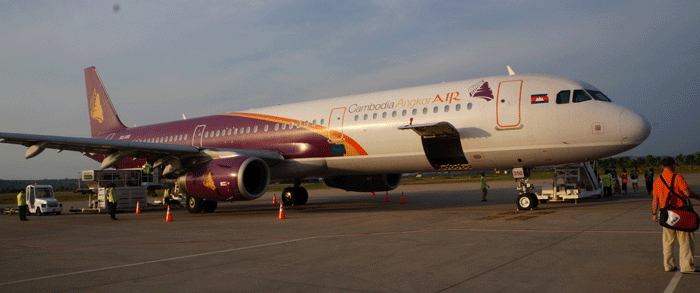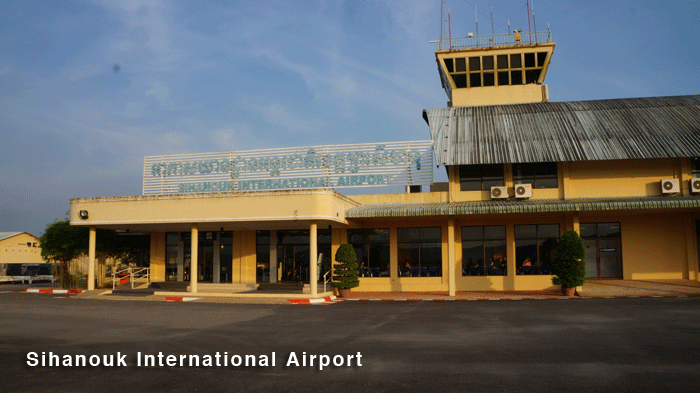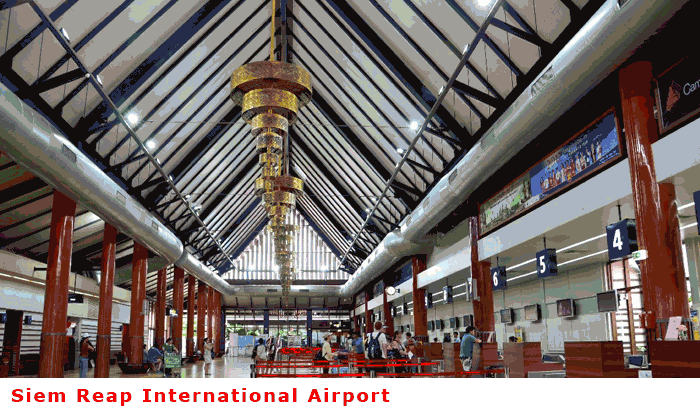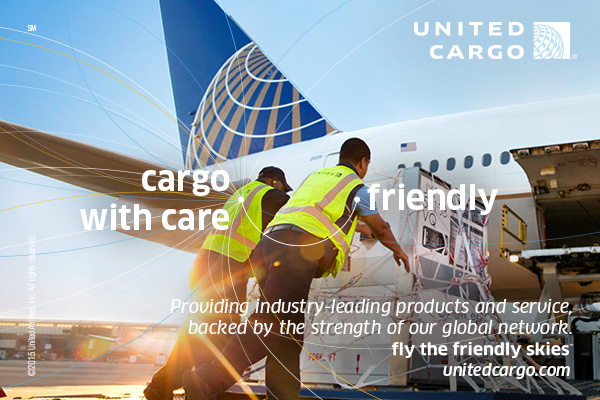| 
The resort town of Siem Reap in northwestern Cambodia
is breathtakingly beautiful. It stands as the gateway
to the ruins of Angkor, which was the seat of the Khmer
Kingdom from the 9th-15th centuries. The airport has
a small-town feeling—quite understated and lovely.
Phom
Penh Exclusive
Looking
for new markets remains a priority for some executives,
especially after a rather lackluster and in some quarters
even sluggish 2015.
Now in 2016, uncertainty
over China finding the next big thing continues as the
long predicted migration of manufacturing to the low
cost labor pool areas of Southeast Asia occurs.
Looking at the airlines,
despite the apparent continued success of Gulf operators
EK, EY, QR, and others—notably Turkish Airlines—
a growing portion of their cargo business is a trending
shift from European and Asian operators to the more
sophisticated cargo products offered by these carriers.
However, further growth
in terms of new business remains a challenge as the
pace of opening new gateways has also begun to gain
a regular, if slightly slowed, rhythm.
A driver affecting both
ocean and air is the slowdown in China, with its growing
middle-class, which now constitutes roughly the population
of the entire USA.
Chinese workers having
pulled themselves up from the sweatshops, many with
positions in the future of China—they are off
buying Buicks and other consumer goods.
Enter the efforts of
the Chinese government looking to farm out or even release
some manufacturing to other, less advanced Asian countries.
Cambodia
The Kingdom of Wonders
A recent article in The
Phom Penh Post suggests some interesting possibilities
that, if realized, might bring this ancient, often overlooked
country—with its burgeoning, underpaid population
eager for an economic breakout—four square into
manufacturing and transportation,
But first we must back
up a bit and look at the air transport industry in Cambodia,
which we learn from The Post is enjoying a
previously unprecedented success despite the shortcomings
in the Cambodian regulatory system, a serious lack of
oversight, and a legal system making operating an airline
quite a daunting task.
Cambodia has long been
known as the one spot in Asia where airlines sprout
like mushrooms after rainfall and vanish even faster
than they have started.
Here are only some airlines
that have come and gone in Cambodia: Aero Cambodia Airlines,
Air Dream, Angkor Airways, Cambodia Airlines, First
Cambodia Airlines, Imtrec Airlines, Kampuchea Airlines,
Mekong Airlines, Progress Multitrade Transport PMT Air,
and President Airlines.
Notably, the carrier
Siem Reap Airways International (FT), a spin-off from
the Thai-based Bangkok Airways (PG) with Thai-trained
crews and aircraft maintained in Thailand, was doomed
by the political tensions between Thailand and Cambodia.
Siem Reap International shut down its operations in
2008.

Cambodia Angkor Air (K6),
owned jointly by the Cambodian government (51 percent)
and Vietnam Airlines (VN), with planes leased from VN
and maintained and staff trained in Vietnam, succeeded
Siem Reap International.
Apsara Air, IP, restructured
in 2014 after near bankruptcy and with operations recommenced
in October 2014, currently operates a lone A321.
Cambodian and Chinese
investors jointly own IP.
Some
Newer Cambodian Services
Bassaka Air, 5B, launched
its maiden flight in December 2014 and currently operates
two A320 between Phnom Penh and Siem Reap as well as
Macao.
Another stronghold is
5B’s connection with the Cambodian/Chinese Naga
Corporation, which operates multiple casinos in Cambodia;
on behalf of Naga Corporation, charter flights to the
Chinese mainland fly wealthy and not-so-wealthy gamblers
to Cambodia from Changsha Hunghua (CSX) and Xi’an
(XIY).
Another upstart is Cambodia
Bayon Airlines (BD), which commenced service in December
2014.
Cambodia Bayon Airlines
currently serves the Cambodian domestic market and Vietnam
as its sole international destination and operates flights
between Phnom Penh (PNH), Siem Reap (REP), and Sihanoukville
(KOS) as well to Ho Chi Minh City (formerly Saigon,
SGN).
As a wholly owned subsidiary
of Chinese Joy Air (JR), BD has 10 A320-200 and another
18 MA-60 on order, slated to enter service between late
2016 and 2019.
BD will, if their ambitious
business plans come true, shake up not only the Cambodian
domestic market but also gain a significant chunk of
the traffic between Cambodia and neighboring Vietnam,
Laos, and Myanmar.
Founded in 2011, Sky
Angkor Air (ZA) caters to the booming tourism trade
with Korea, operating flights between Cambodia and Singapore
(SIN), Busan (PUS), Daegu (TAE), Seoul-Incheon (ICN),
and Hanoi Noi Bai (HAN) as well as operating charter
flights to mainland China.

Enter
The Airports
Phnom Penh Pochentong
International (PNH) has recently seen its international
terminal expanded by more than half, making it one of
the most attractive airports in Asia with a taxi-to-gate
time of less than 45 minutes. The facilities in Siem
Reap (REP), home of Cambodia’s biggest attraction,
Angkor Wat, have also been upgraded and expanded to
accommodate the increasing flow of tourists—as
well as a small but steadily growing number of Cambodian
domestic passengers—to this world wonder.
The third airport in
Cambodia dubbed “international,” Sihanoukville
(KOS) has also awoken from its long dormancy, owing
to a rush of European and Asian tourists flocking to
some of the most beautiful Asian beaches, which are
still largely untarnished and fairly empty.
KOS was abandoned during
the Khmer Rouge regime and never reopened until 2007.
Services were halted again in June 2007 after the fatal
crash of PMTair (U4) flight 241, and didn’t resume
until late 2011. However, so far no international services
are operated to and from KOS.

The
Air Cargo Factor
As The Phom Penh
Post pointed out, air cargo saw a 15 percent rise
to and from Cambodia, bringing the total tonnage to
38,065 metric tons according to CAMS, the operator of
the Cambodian airports.
Growing labor unrest
in Cambodia’s all-important garment industry boosted
these figures, The Post reported.
It is important to point
out that while garments are usually shipped by sea using
Sihanoukville Port, outages caused by labor action forced
a speedier means of transport, meaning air cargo carried
a considerable percentage of the exports in 2015.
Whether or not such a
forced shift to the air mode indicates any sustainable
growth remains to be seen, but Cathay Pacific (CX) feels
confident enough in the Cambodian market to deploy freighters
twice a week.
EVA Air (BR) has withdrawn
their biweekly MD11 freighter after focusing on higher
yields to and from the U.S.—a strategy that might
backfire, since the markets do not take kindly to carriers
jumping and abandoning each wagon as they fall in and
out of favor.
Still, the booming tourism
to and from Cambodia necessitates strong air transport
links both internationally and domestically, and carriers
like K6, BD, and 5B—backed by Chinese and Vietnamese
investment capital—are in for the long haul.
Who
Are The Watchdogs?
One main issue overshadowing
Cambodian aviation is the almost complete lack of regulatory
oversight exercised by the government, a lack of safety
regulations and the implementation of internationally
accepted standards, and the biggest problem plaguing
Cambodia—and its ordinary citizens—widespread,
runaway corruption.
So far Cambodia has neither
a labor safety code nor a fire code, and reports about
flagrant abuse by government officials are frequent.
Growth
In Private Initiative
 For example, while international
hotel chains adhere to the fire codes or standards applicable
in their home countries, most of the guesthouses and
smaller hotels all over Cambodia are unfortunately little
more than firetraps.
For example, while international
hotel chains adhere to the fire codes or standards applicable
in their home countries, most of the guesthouses and
smaller hotels all over Cambodia are unfortunately little
more than firetraps.
Still, private initiative
in many cases covers what governmental regulation lacks:
FlyingTypers
spoke to Hen Leat Cheang, General Manager of the Eureka
Villas Hotel, a lovely, small hostelry in the heart
of Phnom Penh City, about 25-minutes from Phnom Penh
International Airport.
The place is owned by
a retired Australian firefighter who trained Hen in
fire fighting and prevention techniques.
Today Hen promotes and
sells this equipment in Cambodia and conducts classes
in firefighting training.
“As the only reliable
source of specialized fire-safety equipment, we see
our small business as an essential that has been instrumental
in saving lives throughout Cambodia,” Mr. Hen
told FlyingTypers. Contact: hen@eurekavillas.com
Jens
|











 “We
will support package delivery to the rapidly growing
number of prime members who love ultrafast delivery,”
Dave Clark, (left) Amazon’s SVP Worldwide Operations
and Customer Service told The Wall Street Journal on
May 5th.
“We
will support package delivery to the rapidly growing
number of prime members who love ultrafast delivery,”
Dave Clark, (left) Amazon’s SVP Worldwide Operations
and Customer Service told The Wall Street Journal on
May 5th.






 For example, while international
hotel chains adhere to the fire codes or standards applicable
in their home countries, most of the guesthouses and
smaller hotels all over Cambodia are unfortunately little
more than firetraps.
For example, while international
hotel chains adhere to the fire codes or standards applicable
in their home countries, most of the guesthouses and
smaller hotels all over Cambodia are unfortunately little
more than firetraps.